12 Meissen Porcelain Styles That Define European Ceramic Mastery
For centuries, Meissen porcelain has been a hallmark of European ceramic mastery. Known for its precision and artistry, Meissen has produced works that are both timeless and highly regarded. Its various styles reflect the evolution of craftsmanship, with each period bringing something new and exciting. Whether used for decorative or functional purposes, Meissen porcelain brings an undeniable elegance to any space. These unique pieces have inspired many collectors, setting a standard for ceramic art.
This post may contain affiliate links, which helps keep this content free. Please read our disclosure for more info.
Meissen Blue Onion (Zwiebelmuster)
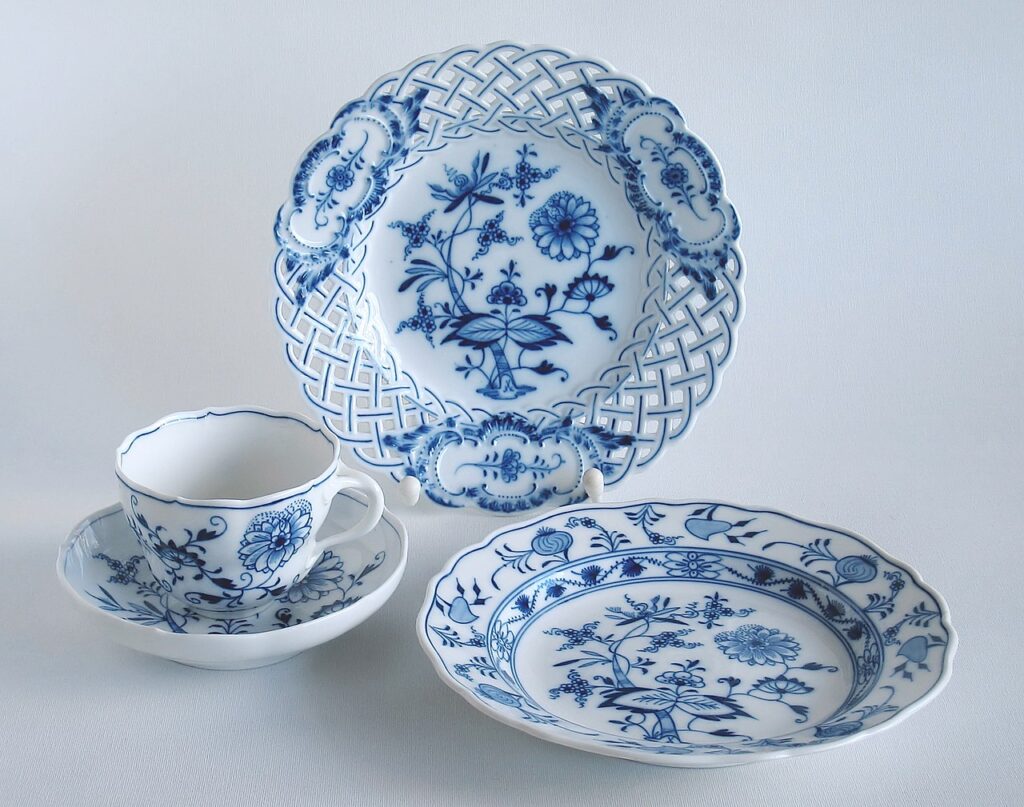
The Blue Onion pattern, introduced in 1739, is one of Meissen’s most iconic and enduring designs. The pattern draws inspiration from Chinese porcelain, featuring stylized fruit, flowers, and bamboo. The distinctive blue-and-white color scheme remains a hallmark of Meissen’s legacy in European ceramics. It was originally intended to appeal to European tastes for exotic imports and became widely popular across Europe. Today, original Blue Onion pieces can fetch several thousand dollars depending on rarity and condition.
This design combines European artistry with Asian influence, marking the fusion of two cultures in porcelain. The design’s crisp and symmetrical patterns symbolize Meissen’s mastery in detailed painting. The use of cobalt blue underglaze adds depth and richness to the delicate floral motifs. Collectors seek Blue Onion pieces for their historical value and intricate beauty. Prices for original and well-preserved pieces remain strong in the collector’s market.
Meissen Swan Service (Schwanenservice)
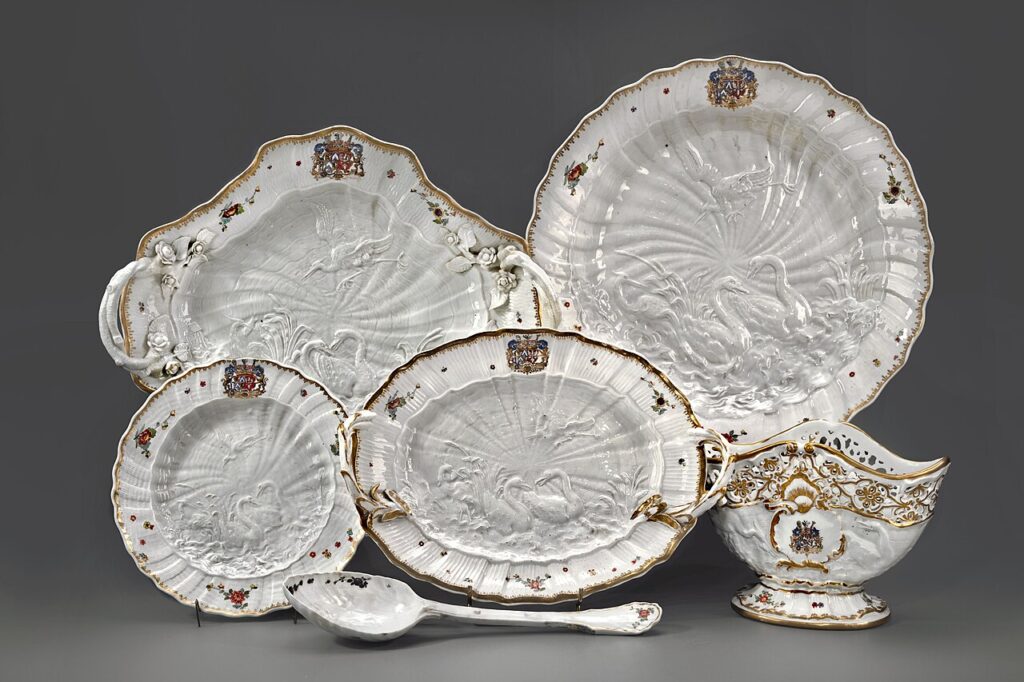
Created in the 1730s for Count Heinrich von Brühl, the Swan Service is a grand collection of over 2,000 pieces. It features sculptural elements of swans and water motifs, often in relief, creating a striking visual effect. Meissen’s innovation with this service was to merge porcelain’s elegance with elaborate design. The Swan Service remains one of the most lavish and elaborate porcelain collections ever produced. Due to its rarity and artistic significance, pieces from this collection can reach several hundred thousand dollars at auctions.
The Swan Service symbolizes the height of Meissen’s luxury production in the 18th century. Each piece was handcrafted with remarkable attention to detail and design. The swan, a symbol of purity and grace, serves as a focal point in many of the pieces. As one of the most expensive and sought-after Meissen designs, the Swan Service’s historical value and craftsmanship make it a crown jewel in European porcelain artistry. The service exemplifies the lavish taste of European aristocracy and continues to be a highly prized collector’s item.
Meissen Red Dragon (Roter Drache)
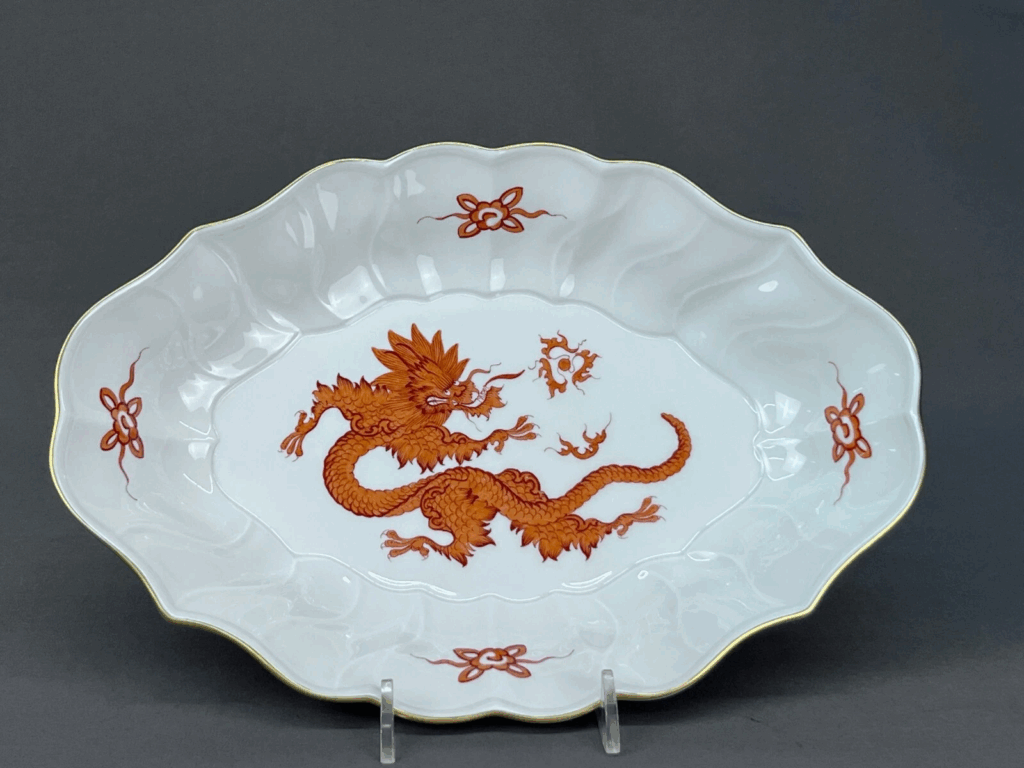
The Red Dragon pattern, introduced in the mid-18th century, showcases a bold red dragon motif, a symbol of power and strength. This design was inspired by Chinese porcelain and reflects the European fascination with the Far East during that period. The red color stands out in stark contrast to the delicate white porcelain, creating a dramatic effect. The intricate detailing of the dragon, surrounded by floral elements, highlights Meissen’s skill in fine porcelain painting. Due to its striking appearance and limited availability, pieces with this design can fetch prices ranging from several thousand dollars.
The Red Dragon pattern reflects the influence of China on European taste and craftsmanship in the 18th century. Meissen’s use of underglaze red allows for a striking and vibrant presentation. The design was highly sought after by collectors who admired the exotic and powerful symbolism of the dragon. This design remains a popular choice among those who appreciate the fusion of European and Asian artistic traditions. Its rarity and aesthetic appeal make it a valuable addition to any porcelain collection.
Meissen Dresden Flowers (Meissener Streublumen)
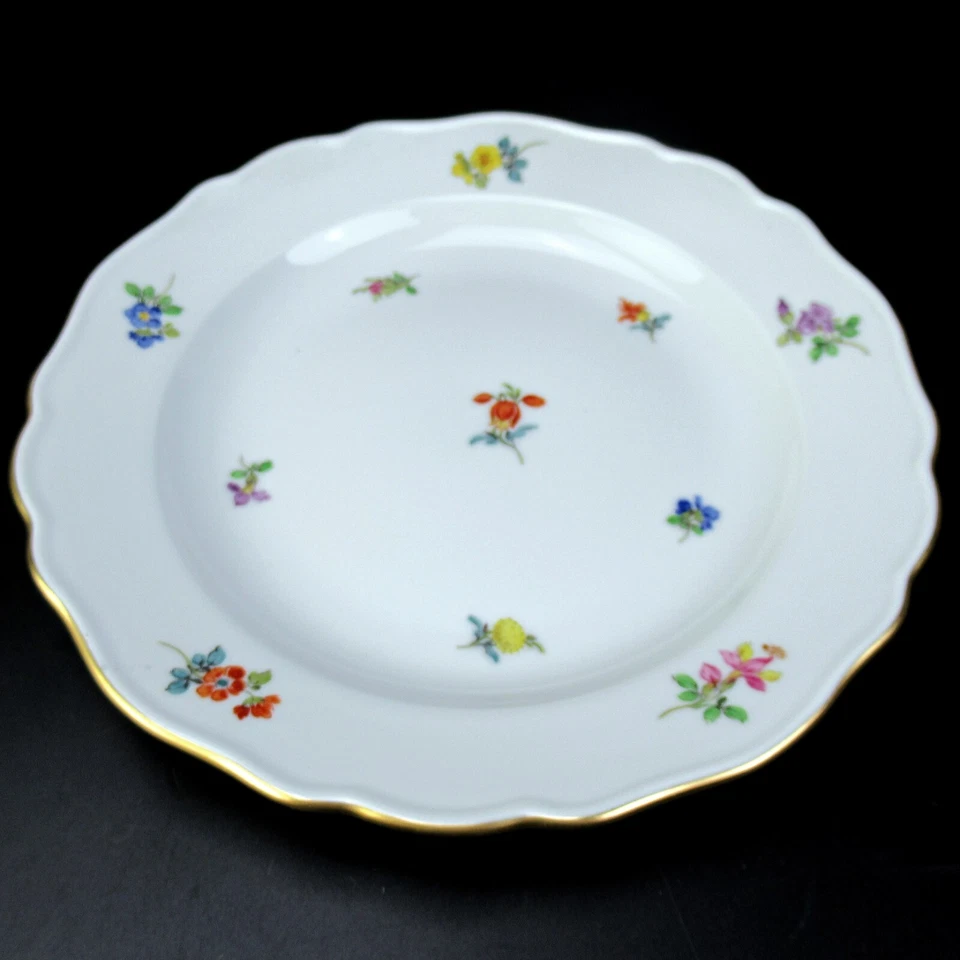
First introduced in the 19th century, the Dresden Flowers pattern features colorful, hand-painted floral arrangements scattered across the surface of the porcelain. This design focuses on delicate depictions of European garden flowers, creating a lifelike, natural effect. The use of vibrant colors and intricate detailing makes each piece a miniature work of art. Originally designed for fine tableware, it continues to be a symbol of Meissen’s craftsmanship. The market value of pieces with this pattern can vary, but rare and well-preserved items can reach prices of several thousand dollars.
This design reflects the growing European interest in botanical illustration during the 19th century. The artist’s attention to detail and mastery in floral rendering elevates the Dresden Flowers pattern as a sought-after design in porcelain. The scattered floral motif creates a sense of spontaneity and natural beauty that appeals to collectors. Meissen’s porcelain artistry during this period was characterized by a refined focus on nature and beauty. The enduring popularity of Dresden Flowers pieces makes them highly desirable in the world of ceramic collecting.
Meissen Snowball (Schneeballen) Design
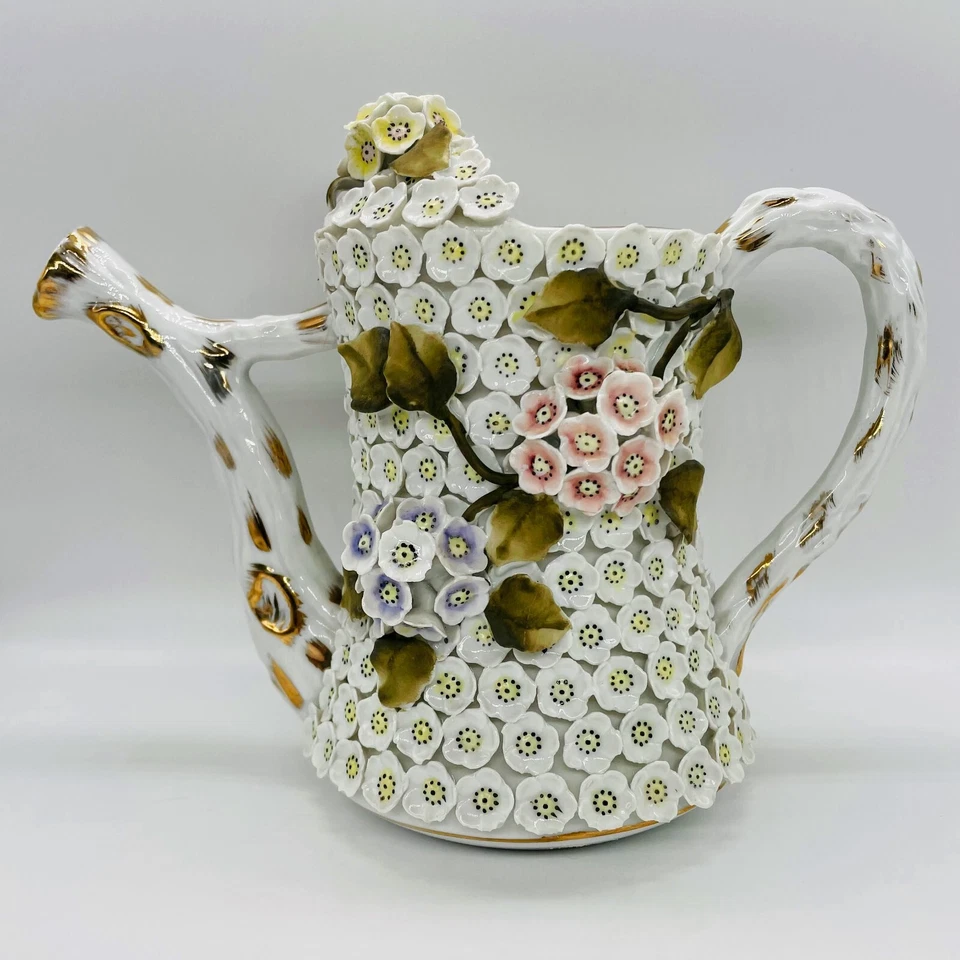
The Schneeballen design, introduced in 1739, features clusters of porcelain snowballs applied to the surface of the piece. This technique was developed by Johann Joachim Kaendler, Meissen’s leading sculptor, and is renowned for its intricate detail. The three-dimensional snowballs give the pieces texture and depth, creating a striking visual effect. The design was revolutionary at the time for its complexity and creativity. Today, Schneeballen pieces are considered rare and valuable, with some items reaching thousands of dollars at auction.
The design is a reflection of Meissen’s innovative spirit and commitment to creating unique, high-quality porcelain. Each piece is meticulously crafted, with small porcelain balls added by hand to create the textured surface. The Schneeballen pattern’s bold appearance and tactile quality set it apart from other Meissen designs. These pieces were primarily used for decorative purposes, and their rarity makes them highly collectible today. Due to their historical significance and intricate design, Schneeballen pieces hold a special place in the world of European porcelain.
Meissen Indian Flowers (Indianische Blume)
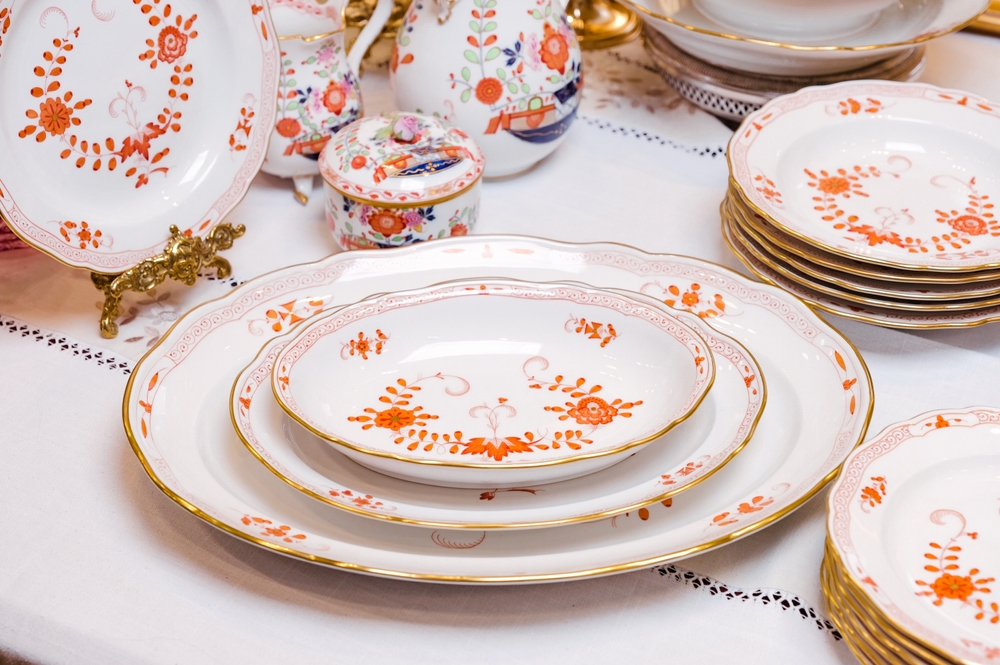
The Indianische Blume pattern combines elements of Chinese and Japanese porcelain, blending European interpretations of Eastern motifs. First introduced in the 18th century, the design features bold, colorful floral patterns with Asian influences, such as lotus flowers and peonies. This fusion of styles reflects the European fascination with exotic art during that time. The vibrant colors and bold patterns make the Indian Flowers pattern stand out in any collection. The value of pieces featuring this design can vary, but they are generally priced at several thousand dollars.
This pattern was influenced by Augustus the Strong’s extensive collection of Asian art, which sparked European interest in Chinese and Japanese ceramics. The bold, graphic nature of the design offers a stark contrast to the more delicate European floral styles. Indianische Blume pieces often feature intricate detailing, with flowers and birds depicted in bright, lively colors. The fusion of European and Asian styles marks a significant moment in the history of European porcelain. Today, this design remains popular with collectors who appreciate its historical and cultural significance.
Meissen Bottger Stoneware
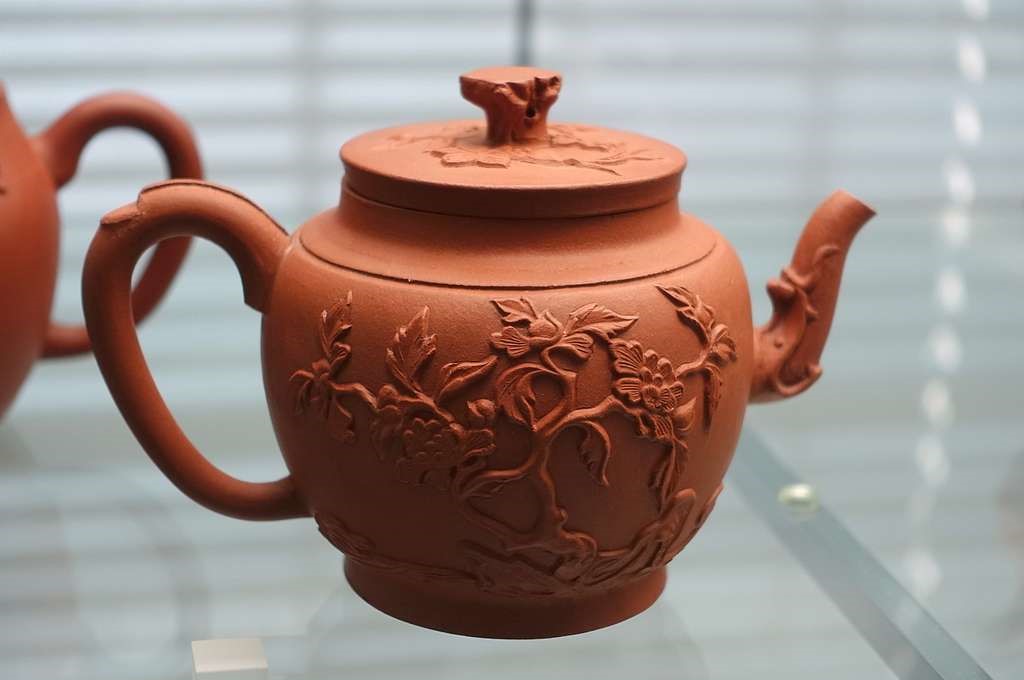
Johann Friedrich Bottger’s innovation in the early 18th century led to the creation of Bottger stoneware, a red stoneware that preceded the famous white porcelain Meissen is known for. The stoneware is characterized by its smooth, polished surface and finely detailed craftsmanship. It was modeled after Chinese Yixing stoneware, which was highly admired in Europe at the time. Bottger stoneware was used to create teapots, coffee pots, and decorative pieces, and it was often prized for its rich, earthy appearance. Today, Bottger stoneware is highly collectible, with rare pieces commanding prices in the range of thousands of dollars.
The creation of Bottger stoneware marked a significant step in the development of European ceramics, as it was the first stoneware produced in Europe. This development paved the way for Meissen’s later porcelain successes, setting the stage for the brand’s dominance in ceramic artistry. Bottger’s mastery in stoneware also led to the eventual creation of Meissen porcelain, which revolutionized the ceramic industry. The rarity of Bottger stoneware, combined with its historical importance, makes it highly sought after by collectors. Original pieces continue to be valued for their historical significance and craftsmanship.
Meissen Monkey Band (Singende Figuren)
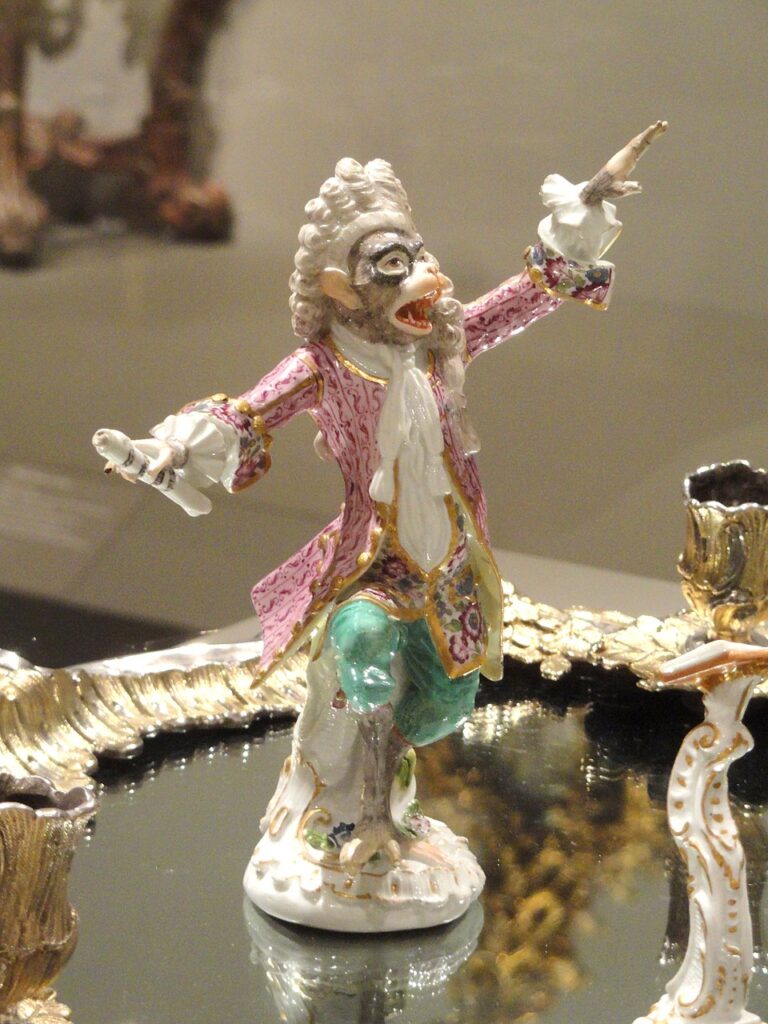
First created in the 1750s, the Monkey Band features a group of monkeys dressed as musicians, each playing various instruments. Modeled by Johann Joachim Kaendler, these whimsical figures reflect the 18th-century European fascination with singerie, a style depicting monkeys in human activities. The playful nature of this design, combined with Meissen’s expert sculpting, made the Monkey Band one of the most popular and enduring figurine collections. Rare and complete sets from this series can fetch several thousand dollars, making them highly valuable on the collector’s market.
The Monkey Band represents Meissen’s creativity in combining humor with fine porcelain craftsmanship. The intricacy of the monkeys’ costumes and the expressive details in their faces add to the charm of these figures. Each musician plays a different instrument, creating a lively and entertaining scene. This series, with its combination of humor and fine artistry, is a significant part of Meissen’s figurine legacy. As one of the most recognizable Meissen designs, the Monkey Band remains a beloved collector’s item today.
Meissen Four Continents
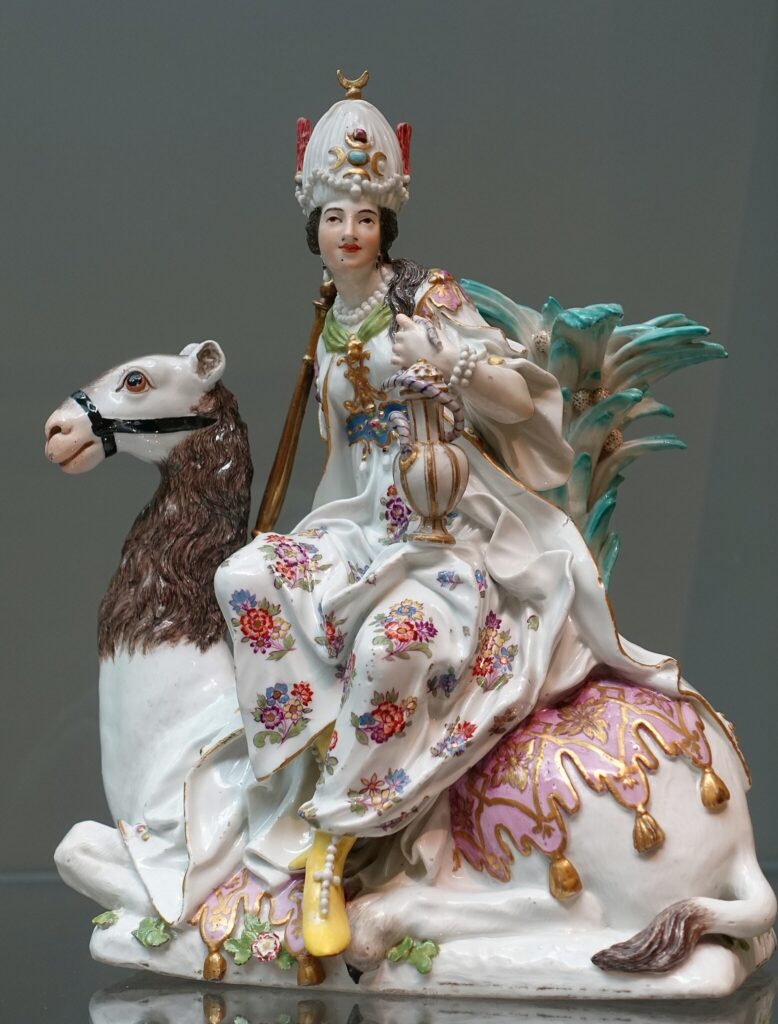
The Four Continents series was introduced in the mid-18th century, featuring allegorical figures representing Europe, Asia, Africa, and America. Modeled by Johann Joachim Kaendler, these figures reflect the global expansion of European influence during the 18th century. Each figure is intricately detailed and dressed in costumes that reflect the continent’s traditional attire. The series was originally commissioned for the Japanese Palace in Dresden, symbolizing the vast reach of European colonial powers. Pieces from this series are rare, and some can reach prices in the range of several thousand dollars at auction.
The Four Continents figures reflect the Enlightenment-era fascination with geography, exploration, and colonialism. Each figure embodies the characteristics and customs associated with the respective continent, often portrayed in highly stylized and elaborate costumes. These figurines were designed to be both decorative and educational, showcasing the diversity of the world as understood by Europeans at the time. Today, the Four Continents series is prized for its historical significance and craftsmanship, making it one of the most important Meissen designs. These figurines remain a valuable and sought-after item for collectors of Meissen porcelain.
Meissen Vine Leaf Pattern
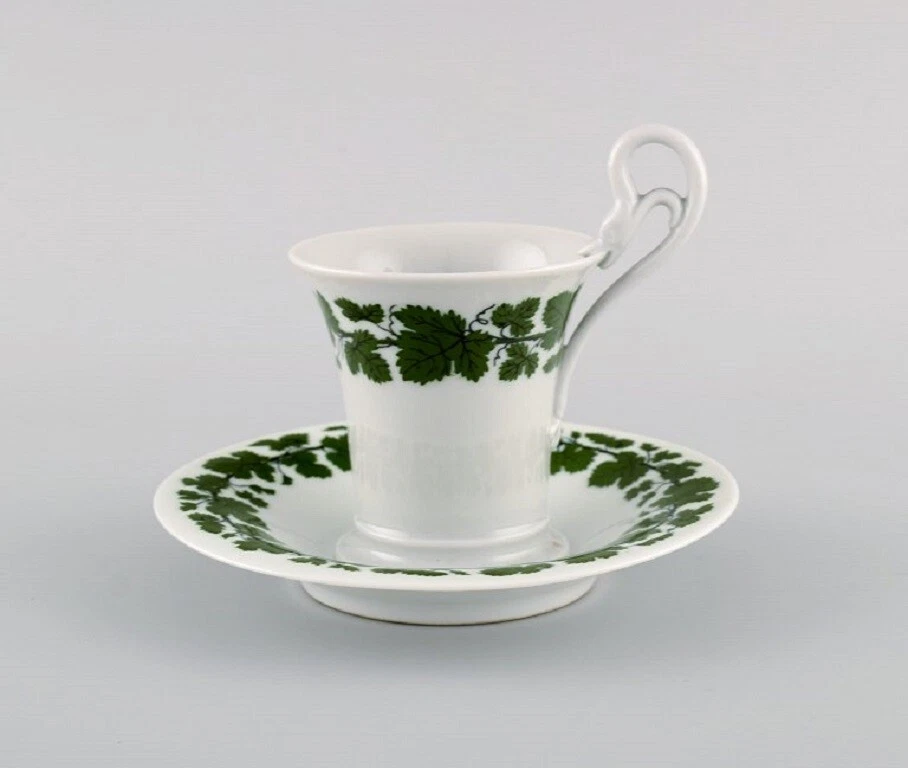
The Vine Leaf pattern, introduced in the 19th century, features stylized grapevines and leaves, often set against a white or lightly colored background. This design reflects Meissen’s ability to capture the beauty of nature in porcelain, showcasing the brand’s skill in botanical illustration. The flowing lines of the vines and the delicate rendering of the leaves make this pattern a standout in Meissen’s collection. Pieces with the Vine Leaf pattern are sought after by collectors for their timeless beauty and craftsmanship. The price for these pieces can range from a few hundred dollars for smaller items to several thousand for larger or rare pieces.
The Vine Leaf pattern is part of a broader trend in 19th-century European porcelain, where natural motifs became increasingly popular. The design reflects a growing interest in garden and floral themes, which were in vogue during this period. The delicate lines and natural beauty of the vine leaves give the pattern an organic, free-flowing feel. It is one of the more affordable Meissen patterns, though its beauty and detailed craftsmanship still command a premium. Vine Leaf pieces remain an attractive option for collectors of fine porcelain.
Meissen Court Dragon Pattern
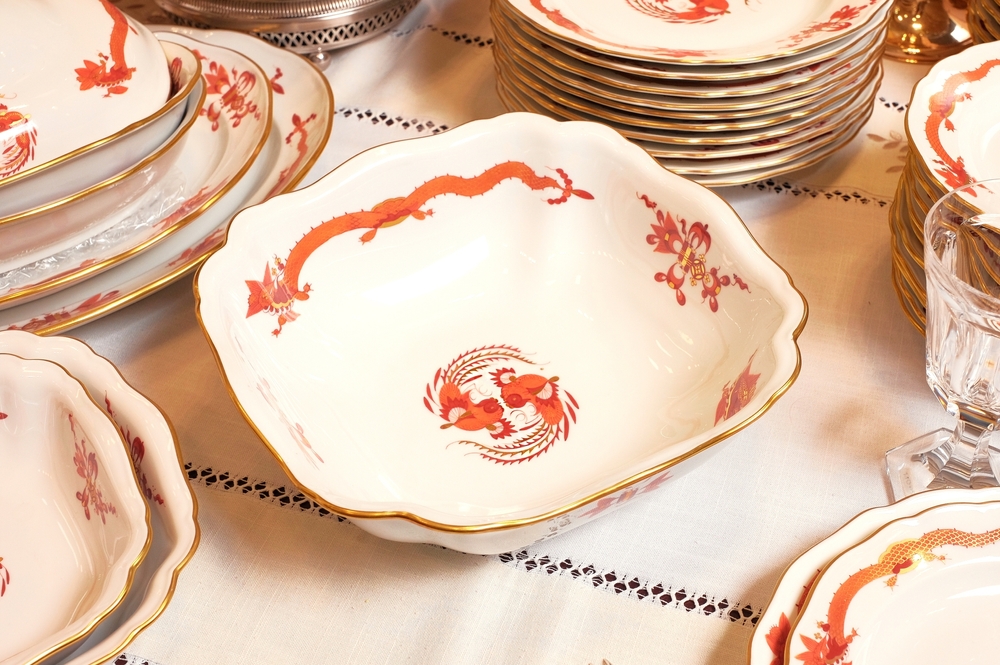
The Court Dragon pattern, introduced in the 18th century, features Chinese dragons in underglaze red with gilt accents, often seen encircling the rim of plates or adorning vases. The design reflects the 18th-century European fascination with China and Chinese art. The use of underglaze red for the dragons, contrasted with the porcelain’s white surface, creates a bold and eye-catching effect. The Court Dragon pattern is highly regarded for its dramatic appearance and is considered one of Meissen’s most striking designs. Original pieces from this pattern are rare and can fetch prices in the several thousand-dollar range.
The dragon is a powerful symbol in Chinese culture, representing strength, good fortune, and protection. Meissen’s interpretation of the dragon, with its dynamic pose and intricate details, reflects the company’s ability to adapt Eastern motifs to European tastes. The Court Dragon pattern became popular in the 18th century, especially among the European elite, who valued the exotic nature of the design. Today, collectors seek out Court Dragon pieces for their historical significance and unique, high-impact visual appeal. The rarity of these pieces makes them highly valuable in the world of porcelain collecting.
Meissen B-Form Pattern
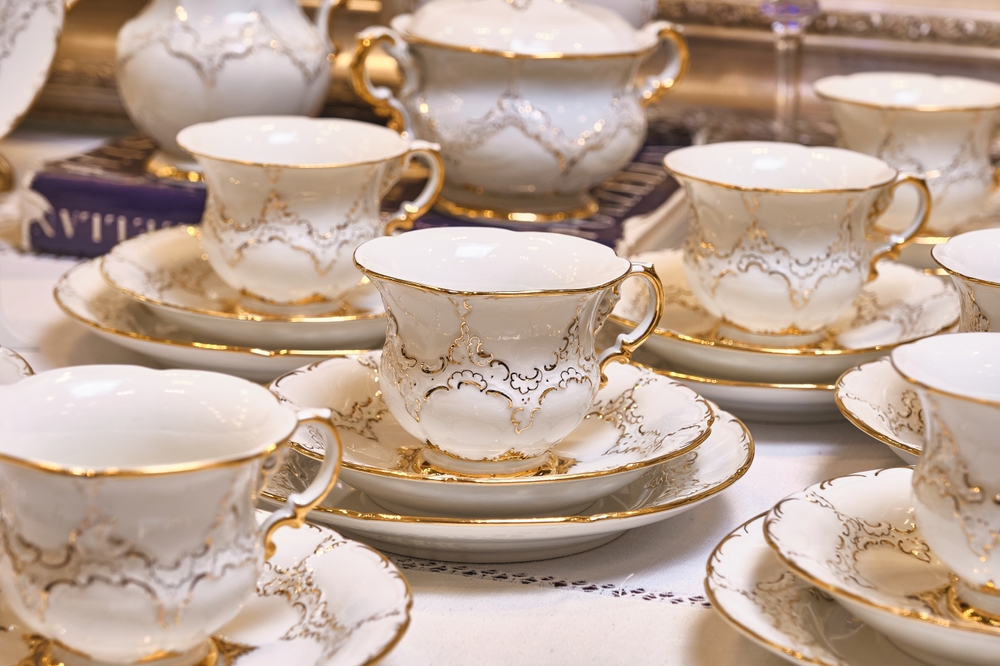
The B-Form pattern, introduced in the 18th century, is characterized by a distinctive scalloped edge and intricate detailing on the porcelain. The design was widely used for Meissen’s plates, teapots, and other tableware, often highlighted with gold accents. The B-Form pattern is recognized for its elegance and refinement, with ornate decorations that add a luxurious touch to any collection. Pieces with this pattern are highly collectible, and their value can range from several hundred to several thousand dollars, depending on rarity. Collectors appreciate the B-Form pattern for its historical significance and sophisticated design.
This pattern reflects the Rococo and Baroque influences that shaped European porcelain during the 18th century. The scalloped edges and delicate detailing evoke a sense of opulence and craftsmanship. The B-Form pattern is a perfect example of how Meissen combined form and function to create porcelain that was both beautiful and practical. As one of Meissen’s more recognizable patterns, it continues to be a sought-after choice for collectors and enthusiasts alike. The timeless beauty of the B-Form pattern ensures its place in the history of European ceramic artistry.
This article originally appeared on Avocadu.
